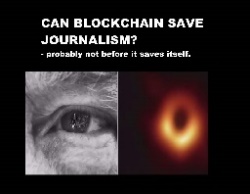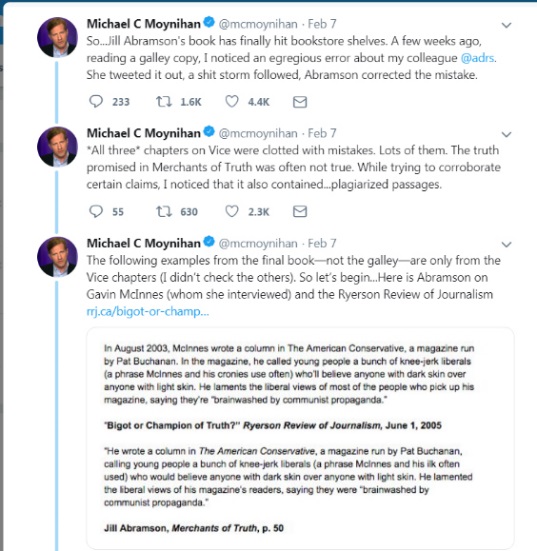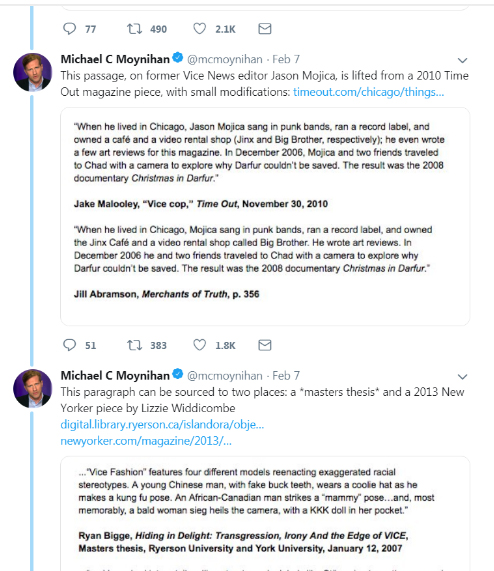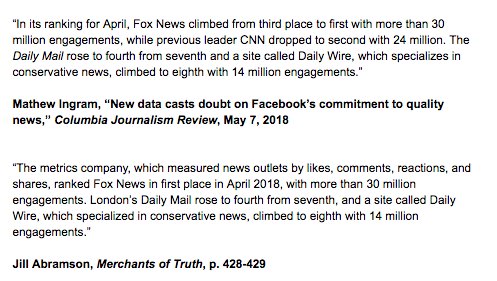
[poet-badge]
[Estimated reading time 2 minutes, 35 seconds]
 Jill Abramson was the editor for The New York Times until 2014 when she was fired by the owner Arthur Ochs Sulzberger Jr., the Times ‘s publisher since 1992, and heir to the Tennessee newspaper baron, Adolph Ochs, who bought The New York Times[1] more than a hundred years before.
Jill Abramson was the editor for The New York Times until 2014 when she was fired by the owner Arthur Ochs Sulzberger Jr., the Times ‘s publisher since 1992, and heir to the Tennessee newspaper baron, Adolph Ochs, who bought The New York Times[1] more than a hundred years before.
Earlier this year she published “Merchants of Truth” – a critical study of how The New York Times, the Washington Post (WP) Buzzfeed and Vice were adapting to the new media landscape.
Quickly the book was highlighted in the online debate, not for its reporting, but because it became embroiled in claims of plagiarism.
The short version is that Michael Moynihan, Vice News Tonight on HBO, tweeted out a series of claims of plagiarism. One of the victims was Mathew Ingram, of Columbia Journalism Review.

Moynihan didn’t like the originality of the research for the book, and Ingram concluded in an article in Columbia Journalism Review [2]: “Do I feel as though something has been stolen from me? Not really. It was a factual description, not something creative that I agonized over for weeks. And yet, it’s still irritating that there seems to be no mention of where it appeared at all. Would it have been that hard to say, “as mentioned in CJR”?
That’s in part what plagiarism is — not a law, but more of a standard of behavior that we (hopefully) uphold, especially as journalists.”
Compare for yourself: (from Moynihan´s tweet)[3]
The jury is still out on this one as well. But plagiarism or not, it´s Ingram’s point that’s important here, “irritating that there seems to be no mention of where it appeared”, that could possibly be supported by technology.
But one needs to slice the sausage very thin, something that blockchain can do, but the question becomes – is that proving anything?
The problem, as anyone inspecting the Ingram example above can see, is that it´s not verbatim plagiarism. Abrams has read Ingram’s article and used the facts, and some wording, in her own text. And didn’t footnote.
But machines are stupid and if you would stamp Ingram’s content above as “Made by Ingram” it would not show up in a plagiarism test like Urkund.com.
If you taught the machines to look for the kind of similarities, we see here you would soon end up in a brawl on both authors using the word “and” – which hardly is plagiarism. In legal terms “and” does not reach the level of originality needed to protect its copyright.
Using a metaphorical sausage and thinking about how thin you can slice it gives an idea of how you would end up with molecules if your knife was sharp enough. And blockchain can indeed be a sharp knife watermarking very small pieces of information.
The issue of the thickness of the slice is a crucial one to address if sourcing with the blockchain is going to be part of the solution for plagiarism.
//Updated 20190426//
-
in 1896 ↑
-
Clippings\I was plagiarized by Jill Abramsonon – Columbia Journalism Review.pdf ↑
-
https://twitter.com/mcmoynihan/status/1093291666264506369 accessed 2019-03-31 Clippings\Michael C Moynihan on Twitter_ accessed 20190331pdf.pdf ↑
-
https://twitter.com/mcmoynihan/status/1093291666264506369 accessed 2019-03-31 ↑


